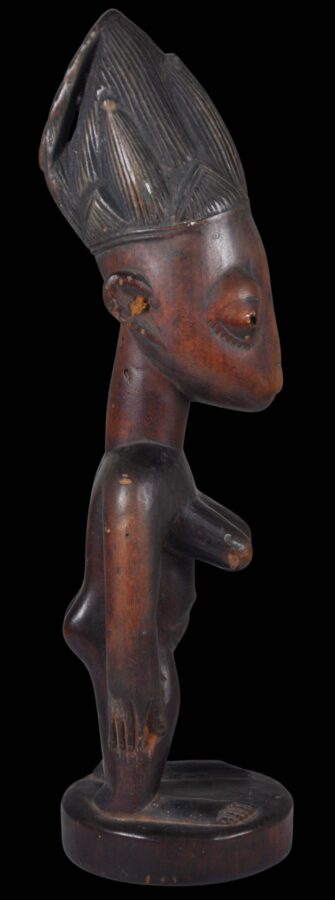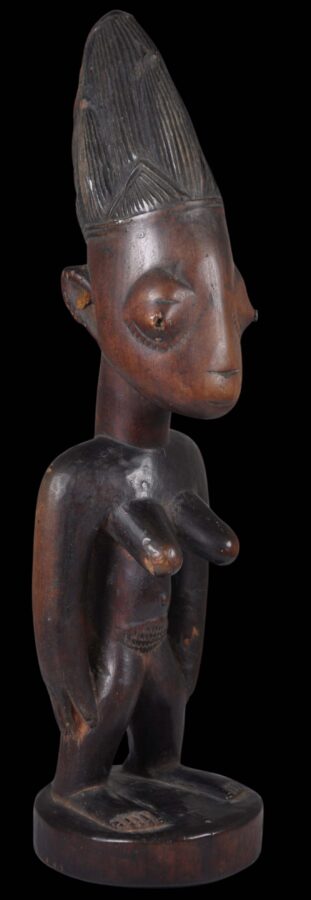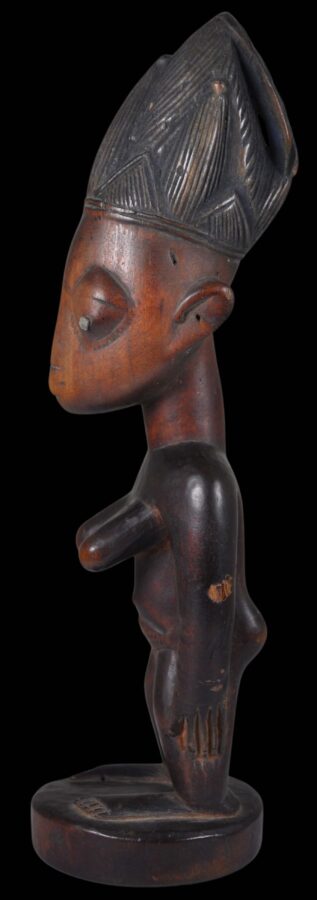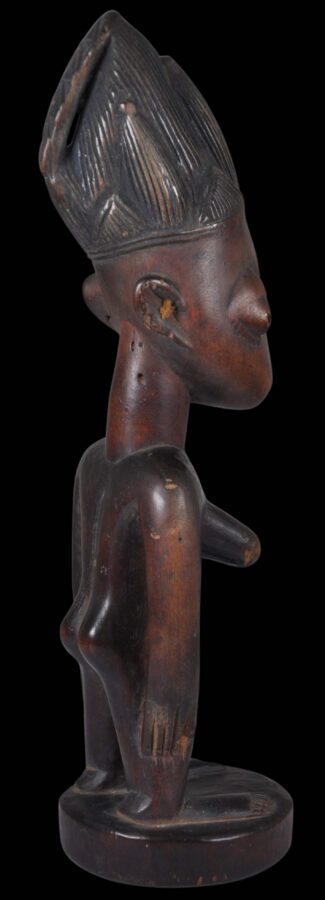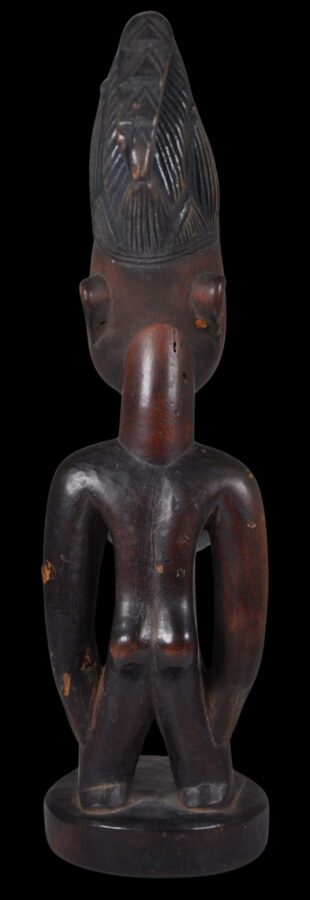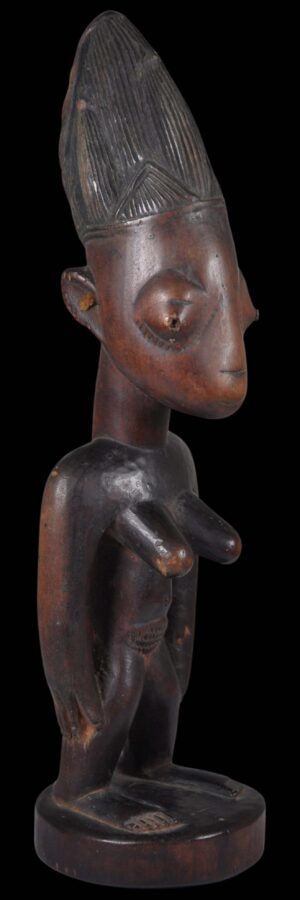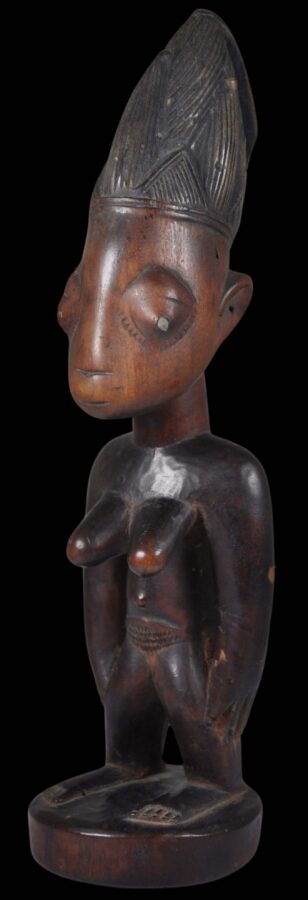Enquiry about object: 9645
Rare Yoruba Ere Ibeji Female Figure Devoted to Eshu
Igbuke, Oyo Region, Nigeria 19th-early 20th century
height: 27.5cm, weight: 206g
Provenance
private collection, UK
This female Ere Ibeji is unusual in that it also incorporates Eshu characteristics.
It has a good, deep patina with contours that have been softened and rounded from handling.
The figure stands with hands resting just below the hips, with legs apart, and with protruding breasts. The details of the face have largely been worn away from years of caressing, bathing and handling. But the face is elongated, and the eyes are wide, bulging and characteristically almond shaped. Pupils have been denoted with the head of an iron nail, though one is missing. The head is over-sized – the head is where the spirit resides. Among the Yoruba, the over-sized head is associated with one’s destiny, and can be a measure of one’s likely success or failure.
The tall coiffure resembles a high crown – it has been finely carved with much detail.
The back of the head includes a carved wooden pendant drop of a type usually seen on figures made for Eshu worship, suggesting that this figure served a dual purpose of being both an Ibeji figure and an Eshu figure.
Such Ibjei figures devoted to Eshu are rarely encountered. A related pair is illustrated in Chemeche (2013, p. 275).
The feet of the figure here are long and flat but with finely delineated toes. It stands on a raised, round platform.
Each has a prominent incised triangular patch of pubic hair.
Eshu is one of the most well-known deities in the traditional Yoruba belief system. Generally, Eshu is believed to be male. But Witte (2002, p. 78) argues that Eshu is both male and female. As both male and female, Eshu mediates between both sexes and bridges the sexual energies between men and women.
According to Chemeche (2013, p. 26), Eshu is a trickster who is able to be good and bad, trustful and mischievous, and can deliver prosperity or cause misery. He is the protector of travellers. Most importantly, he is the mediator between the realm of spiritual and mortal worlds. Hence he is the guardian of all rituals. He supervises all the sacrifices to the gods. His long phallic coiffure is unique. It symbolises a power that is both creative and destructive. This power allows him to bless those who perform their rituals properly and correctly with good fortune, and to bring misery to those who do not perform their rituals properly. Eshu is therefore often represented on the shrine alongside other deities.
Yoruba people have the highest dizygotic (non-identical) twinning rate in the world. The birth of twins amongst Yoruba women are four times more likely than anywhere else. Unfortunately, the mortality rate of the twins also was high. Ere Ibeji figures were carved as spiritual representations of the twins who died. These figures were commissioned from village carvers, who were also often highly trained priests (Babalawo). The images were carved as adults, rather than as the deceased infants. It is common in African sculpture that representations of children are made with adult-like qualities, including elaborate coiffures, scarifications on the face, fully developed breasts (on female figures), pubic hair and prominent genitalia. They were usually placed on a shrine dedicated to Elegba (a divine messenger deity) in the living area of the house and fed, bathed and dressed regularly. These figures were particularly special to the mother, who kept them close to her and caressed the figures in a loving manner, hence the wear that genuinely old examples exhibit.
The pair here is in fine condition.
References
Bacquart, J. B., The Tribal Arts of Africa, Thames & Hudson, 1998.
Chemeche, G., Eshu: The Divine Trickster, Antique Collectors’ Club, 2013.
Fagg, W. and J. Pemberton, J., Yoruba: Sculpture of West Africa, Collins, 1982.
Polo, F., Encyclopedia of the Ibeji, Ibeji Art, 2008.
Rowland, A., H.J. Drewal, and J. Pemberton, Yoruba: Art and Aesthetics,Museum Rietberg, Zurich, 1991.
Witte, H., “The World View and Iconography of the Yoruba” in Forms of Wonderment: The History and collections of the Afrika Museum Berg en Dal, Afrika Museum Berg en Dal 2002.


